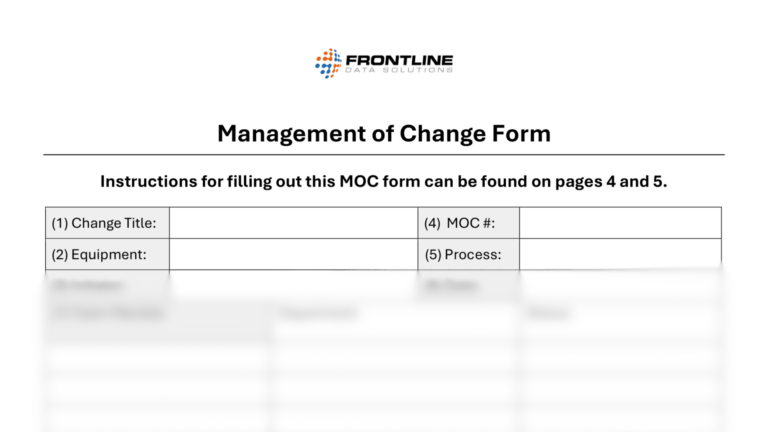As an EHS professional, how many times have you gone to a site and either seen or heard something that wasn’t there before? Perhaps a missed step in the process led to this change. For example, a new piece of equipment, a different process sequence, new materials, chemicals, etc.
It could even be changes to the personnel onsite like a new general manager or an entire department of people. Sometimes, these adjustments may come as a surprise due to oversight, where a step might have been missed.
There are so many companies that have a great process for managing change. However, there are probably just as many (or more) who have absolutely no process for this crucial piece of EHS management.
Free form!
This management of change form walks you through the steps of reviewing changes for process safety compliance. It ensures no step is inadvertently missed during the process.
Why is management of change so important?
One of the vital functions in EHS is to mitigate risks. However, introducing new changes without reviewing them carefully can create serious hazards without anyone realizing it. In particular, when a crucial step gets missed in the process, the potential for incidents increases significantly.
Therefore, you have a responsibility to help identify safety concerns. If you don’t know the risks your workers face every day, it’ll be impossible to control them. Moreover, making changes without a standard process leads to unintended consequences and unnecessary rework.
For example, imagine buying a new piece of process equipment and installing it immediately without assessing its impact on existing systems. Soon afterward, you realize that the change introduces major safety hazards because the team never installed adequate machine guards.
Consequently, you now have to spend extra money retrofitting guards and may even need to shut down the work area—losing valuable production time in the process. Ultimately, a single missed step can become a costly mistake.
Instead of constantly putting out fires caused by organizational changes, implement an MOC process. This process controls how these changes are rolled out across the site.
Why is MOC so often a missed step in the process?
Unless you’re regulated by OSHA’s PSM standard, which includes MOC requirements, you’re not required to have this sort of program onsite.
Many companies, as I said, just don’t have a change management of system in place. Therefore, they don’t really have a standard work and don’t any control documents to help guide people through this process. This often results in a missed step in the process.
To begin with, a company must have an inherent desire to manage changes effectively. Without this foundation, any system you introduce will fail to gain traction and will eventually collapse.
Therefore, recognize the value of implementing changes carefully before setting this standard for your team. By doing so, you build a foundation for accountability, consistency, and long-term improvement.
Moreover, EHS performance depends on the level of commitment from company leadership. When senior leaders prioritize it, progress follows. Ultimately, leaders must view management of change as a value-added process for it to succeed.
Why should everyone have a change management process?
If you’re trying to argue the case for an MOC process, put it this way:
The issues created by haphazard change implementation cost the company more money than it would cost to invest in an MOC solution.
These costs stem from employee injuries, rework, waste disposal, industrial hygiene testing, and other unexpected backend expenses that result from missed process steps.
In my experience, I have implemented MOC programs by presenting senior managers with a side-by-side comparison of these expenses and the potential safety benefits. Next, review your past projects and gather the detailed cost data for each one.
Afterward, identify the situations where a missed step in the process led to additional expenses—costs you could have avoided with a proper change review before implementation. Then, present your findings to senior management along with a recommendation to implement an MOC program.
If your company does not have an MOC process, advocate for creating one immediately. Establishing a well-defined procedure for managing changes allows you to prevent recurring problems, reduce emergency responses, and move your EHS department toward consistent, measurable improvement.

Jason Hathcoat, CSP
Jason is a seasoned EHS professional with more than 20 years of experience working in health and safety. He currently serves as a Senior EHS Leader at Trane Technologies.





